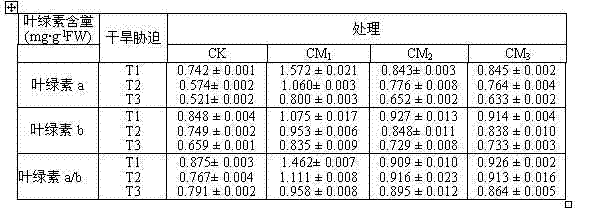Application of waste compost microbial agent to improving salt resistance of lawn grass
A technology for microbial inoculants and compound microbial inoculants, which can be used in applications, fertilizer mixtures, botanical equipment and methods, etc., and can solve problems such as complexity, symbiosis of composting bacteria, and ambiguity of mutual influence relationships.
- Summary
- Abstract
- Description
- Claims
- Application Information
AI Technical Summary
Problems solved by technology
Method used
Image
Examples
Embodiment 1
[0018] 1. Screening of bacterial strains
[0019] ① Enrichment: Weigh 10 g of the collected compost sample into a sterile Erlenmeyer flask, add 100 ml of sterile water and glass beads and shake evenly, then take 10 ml of the suspension in a triangle flask containing 100 ml of enrichment medium. In the bottle, shake culture at 28°C and 220 r / min for 3-5 days. ②Preliminary screening: Dilute the enriched culture solution in a concentration gradient, spread it on the separation and screening medium, incubate at a constant temperature upside down, observe the size of the transparent circle, and select the colony with a large ratio of transparent circle / colony diameter for recombination. screen. ③Growth curve drawing: Inoculate the Bacillus subtilis and yeast obtained from the primary screening into the corresponding shake flask culture medium, culture them at 37°C and 28°C, and 220 r / min respectively, and use wavelengths of 600 nm and The OD value at 560 nm was plotted on the ord...
Embodiment 2
[0023] Application of compound microbial agent
[0024] A single-factor randomized block experimental design was adopted, and the limiting factors were: ① Salt stress, three levels of salt stress treatment; mild (0.3%NaCl): T 1 , Moderate (0.6%NaCl): T 2 and severe (0.9%NaCl) saline-alkali soil: T 3 . ② Apply different concentrations of compound microbial agents, and set the treatment method under this salt stress condition: treatment 1 is the control, without inoculation of the agent (CK); treatment 2 is added with a 100-fold dilution of the agent (CM 1 ); Treatment 3 added 200-fold dilution of the bacterial agent (CM 2 ); Treatment 4 was added with 300-fold diluted bacterial agent (CM 3 ).
Embodiment 3
[0025] Embodiment 3 lawn establishment
[0026] The perennial ryegrass ( Lolium perenne L.) and tall fescue ( Festuca arundinaceaL.) is the test material. The seeds of the tested turfgrass plants were plump and uniform in size. The soil used is the garden soil of Tianjin Normal University. Its physical and chemical properties are: pH 7.44, saturated water content 0.58 ml / g, organic matter 4.68%, total nitrogen 0.21%, available phosphorus 22.03 mg / kg, and total potassium 45.61 g / kg. After collection, remove plant residues, gravel and other sundries, pass through a 2 mm sieve, and sterilize at 121 °C for 30 min for later use. The method of potting was adopted in the experiment, 200 g of sterilized soil was placed in each culture container, and 0.4 g of lawn seeds were sown on it. Provide uniform and quantitative water every day to maintain a good water condition in the culture medium, and change the position of each culture container frequently to ensure consistent light. ...
PUM
 Login to View More
Login to View More Abstract
Description
Claims
Application Information
 Login to View More
Login to View More - R&D
- Intellectual Property
- Life Sciences
- Materials
- Tech Scout
- Unparalleled Data Quality
- Higher Quality Content
- 60% Fewer Hallucinations
Browse by: Latest US Patents, China's latest patents, Technical Efficacy Thesaurus, Application Domain, Technology Topic, Popular Technical Reports.
© 2025 PatSnap. All rights reserved.Legal|Privacy policy|Modern Slavery Act Transparency Statement|Sitemap|About US| Contact US: help@patsnap.com



